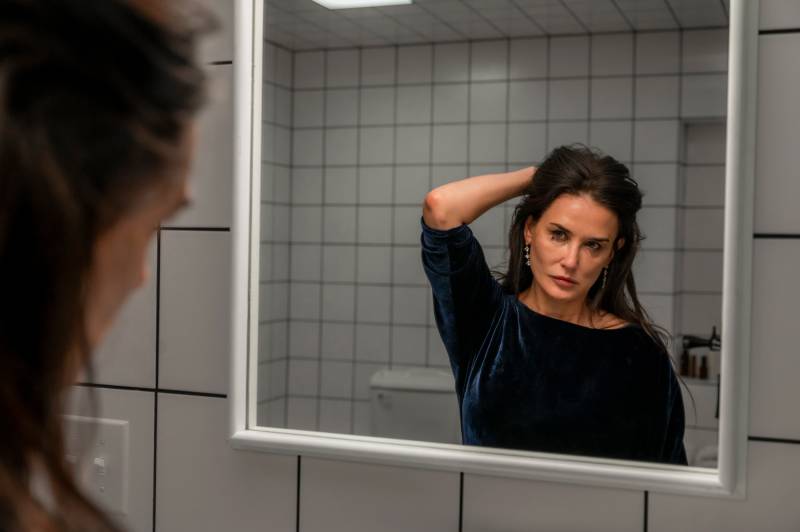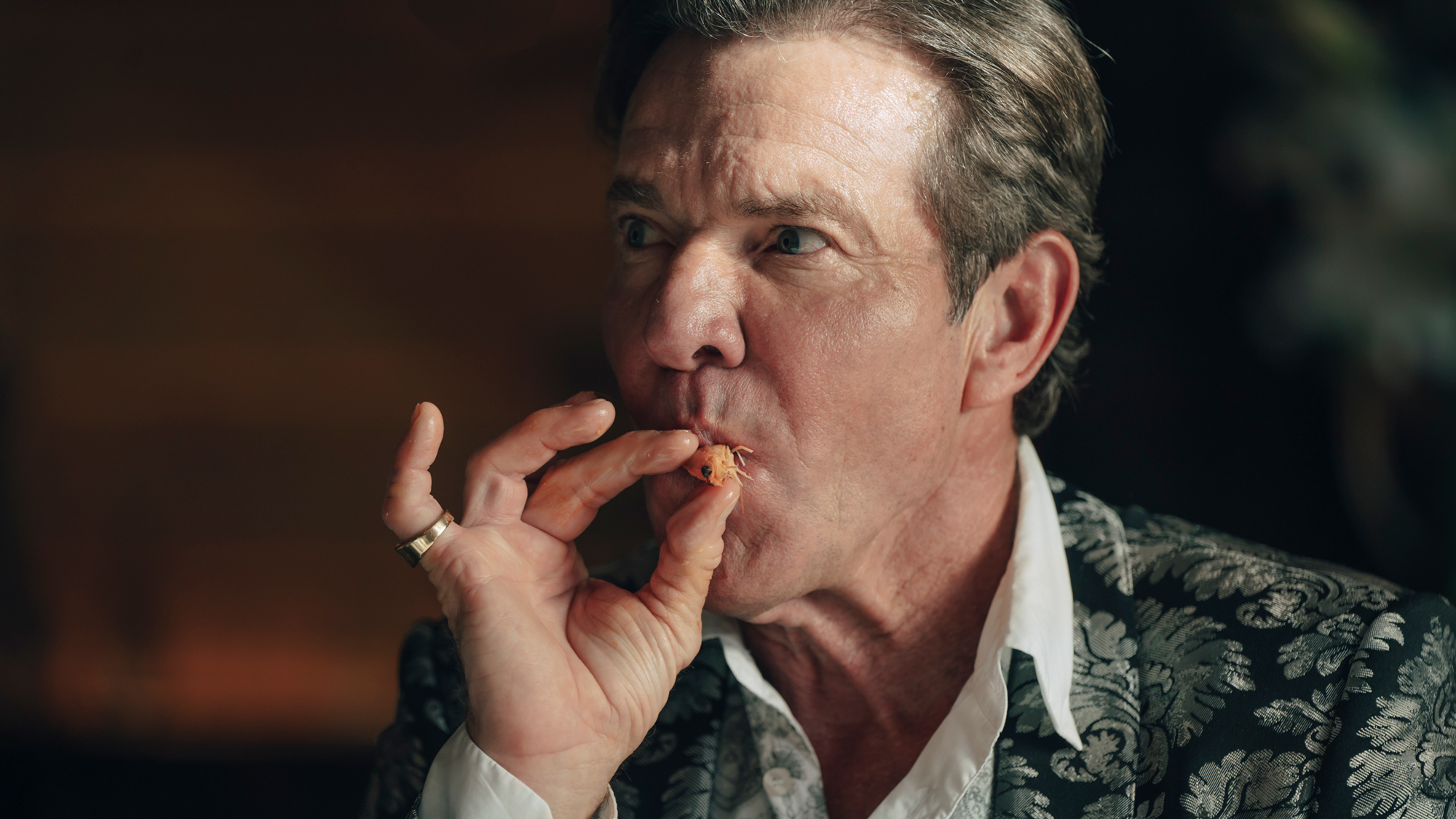A drop, a drip, a splash, a geyser. For a while, the procession and progression of blood in The Substance is deliberate and measured, and done with purpose. But subtlety isn’t French writer-director Coralie Fargeat’s strong suit, and restraint isn’t a hallmark of shock cinema.
Beauty Is a Beast in LA-Set ‘The Substance’

Consequently, The Substance goes off the rails long before Fargeat spins the spigot and drenches the audience in a climactic deluge of crimson. Intended as satire, the movie is off-putting; as social commentary, it’s incoherent; and as a feminist statement, it reeks of vicious self-loathing.
The Substance and its gorgeous cipher of a protagonist, Elisabeth Sparkle (played by Demi Moore), are driven by The Twilight Zone notion that the fountain of youth is available via an injectable, under-the-counter formula. On the back side of a primetime career that garnered her a star on the Hollywood Walk of Fame, Elisabeth is susceptible to a plug for “the substance” (as it’s called) after she’s fired from her daytime-TV exercise program by the network chief (Dennis Quaid, in a grotesquely cartoonish caricature of a leering entertainment exec).

On paper and in theory, the desire for a brand-new 20-something body and wrinkle-free face may seem self-evident and universal. In a world where Botox, plastic surgery and Ozempic are pervasive and routine, the substance would seem to be just one step further. After all, women have always had to suffer to be beautiful. Corsets and girdles have simply been supplanted by better living through chemistry.
But if we are expected to empathize with a flesh-and-blood movie character, we need more. Does Elisabeth crave the work or the fame? Is she afraid that this is the end of her career, and her worth? She didn’t get that star for her looks or her exercise show, so at one time she was an excellent, or popular, actress (even if the only framed piece hanging in her apartment isn’t a movie poster but a portrait of her workout persona). It’s illogical, and anachronistic, that she isn’t being offered roles. (For the record, Moore is 62 and works steadily.)
Yet Elisabeth is barely given a moment of self-doubt or self-reflection, and from all appearances has no friends or agent to confide in and commiserate with. Fargeat’s decision to omit backstory and flesh out the character isn’t a streamlining timesaver — The Substance clocks in at two and a quarter hours — but a calculation that deprives Elisabeth of any internal life. She is the embodiment of “beauty is skin deep,” and it’s not an attractive quality.

The substance, for better and worse, doesn’t rejuvenate Elisabeth’s physique. (Imagine the crazy explanation you’d have to concoct if you showed up one day looking 25 years younger.) Instead, her back splits open and Sue, a fully formed person (Margaret Qualley of Maid), emerges. Fargeat revels in delivering an especially horrific “birth” scene, raw with bewilderment, pain and scars.
The movie’s sets — spotless high-rise bathrooms and TV studios and hallways — largely consist of pristine blocks of primary colors. Eye-catching in their own right, they are designed to display the discharges of the female body for maximum grossness and, especially, shame.
Naturally, the substance comes with procedures and side effects. Elisabeth and Sue share an existence in which they absolutely, positively must “switch” every week. So Sue goes on auditions and acquires a boy toy while Elisabeth is comatose on the bathroom floor. The next week, Elisabeth lounges at home looking out her floor-to-ceiling windows at Los Angeles — and the massive billboard of Sue in a leotard after she is cast, much too conveniently, as the new centerpiece of that daily TV exercise show.
Elisabeth awakens every other week to a mess of empty liquor bottles, the scent of consummated passion and that damn billboard, kindling a fierce jealousy of the life her doppelgänger is enjoying. So she devises a form of payback. Unfortunately, The Substance misses the opportunity for a blackly hilarious duel between bad roommates — Fargeat’s sense of humor veers toward the cruel rather than the comic — and accelerates into the horrible consequences of violating the substance’s protocols.

The dynamic between Sue and Elisabeth devolves into that of a rebellious, full-of-life teenager and a wise-but-frustrated mother. No laughs to be had there, that’s for sure. But instead of heart-wrenching domestic drama, imagine that relationship as a bare knuckle, Grand Guignol cage match (where the cage is a multimillion-dollar condo).
By this point, it’s clear that The Substance isn’t critiquing the male gaze, or the importance (and shallowness) of physical appearance in society, or even the exploitation of youth and beauty by the media, advertisers and corporations. Men in positions of authority, the presumed targets of the revenge we have been anticipating for most of the movie, turn out to be, surprisingly, ancillary players.
In lieu of the satisfying catharsis implicit in that payback scenario — payback for the suffering women endured — The Substance smashes us with something far more disturbing. Sue and Elisabeth’s knock-down-drag-out showdown is a visceral depiction of the rivalry and competition between women. Ah, but Fargeat has an even uglier reality she wants us to confront: women’s fear of aging, exemplified by the loss of beauty.

We’ve finally reached the nasty heart of The Substance. Given the film’s erratic execution, the reaction of female audiences may prove to be its most illuminating element. I expect the response to Sue and Elisabeth — which character women identify and sympathize with more — will correlate with the viewer’s age.
Along with the obvious differences in perspectives on beauty and mortality, I’m thinking of the tolerance for watching violence, and particularly woman-on-woman violence. Be advised Fargeat does not pull any punches.
For all the blood showered on the audience, The Substance doesn’t affect us through its characterizations or performances. Nonetheless, be prepared the next time you look in the mirror.
‘The Substance’ is in theaters Friday, Sept. 20, 2024.



